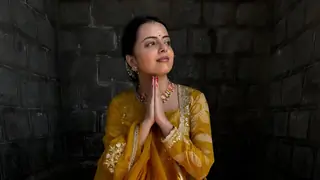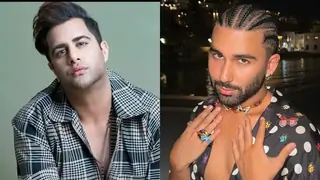The ghazal in Hindi films
The ghazal has existed since Hindi film music has, though like all creative genres it is barely heard today, because it is a poetic rather than musical format
The ghazal has been described as an ?intimate journey from one heart to another?. While usually - but not exclusively - expressive of love or its allied emotions, it is a form of verse that scintillates through its sheer elegance of language and freshness of thought that is often tangential or metaphorical, and often conveys subliminal dimensions and imagery even in simple words like Chaudhvin ka chand ho ya aaftaab ho/ Jo bhi ho tum Khuda ki kasam laajawaab ho (Chaudhvin Ka Chand/ Shakeel Badayuni).
By definition, a ghazal is a collection of two-line couplets that may or may not have a thematic link but are each complete thoughts by themselves. These couplets are written in ?metre? (harmonious phonetic rhythms) and the only connections between them are the allegiance to identical metres as well as a rhyming format wherein the first two lines rhyme with each other and after that with every second line. Since this form of poetry has existed for centuries, it is traditionally permitted to take the first two lines of an existing ghazal and add original lines to them without being accused of plagiarism. Using this formula, poets have penned innumerable verse, including many popular numbers in films like Patta patta buta buta (Ek Nazar/ Majrooh Sultanpuri). Obviously, the exquisite phonetic rhythms of the ghazal has attracted music composers both within and outside cinema, so much so that voices like Jagjit Singh, Pankaj Udhas, Talat Aziz and others in India and Mehdi Hassan and Ghulam Ali in Pakistan have become synonymous with the ghazal as a musical form. On the female side, Begum Akhtar remains the greatest legend, though even today we have names like Penaz Masani who are known for their association with this form. In films, for obvious reasons, the ghazal was experimented with in various ways. The film song, for example, had to have continuity of thought since ghazals here are almost exclusively romantic. The film song also broke the rhyming norm as the traditional mukhda-antara format got precedence over the poetic rules. And gradually the ghazal came to be identified more with a mood and a flowery quality in words, like in Jeeye to jeeye kaise bin aapke (Saajan/ Sameer), Jaane kyoon log mohabbat (Mehboob Ki Mehndi/Anand Bakshi) and Honthon se chhoo lo tum (Prem Geet/Indeewar) among many others. Space does not permit an extensive analysis of the use of ghazals in our movies, but we must point out some interesting aspects. Several songs, while not being ghazals even in a modified format, had the aura or feel of this genre, like Chitthi aayi hai (Naam/Anand Bakshi). Others were ghazals in part (Dard-e-dil/Karz/Anand Bakshi) despite a Westernised musical and audiovisual presentation. The mujra was another genre that used this form of verse (as in the two film versions of Umrao Jaan with lyrics respectively by Shahryar and Javed Akhtar, the mujras of Ek Nazar by Majrooh Sultanpuri and the classic Chalte chalte yun hi koi/ Pakeezah/Kaifi Azmi). Always remembering the fact that this was a form of verse rather than music, the pure ghazal could even be concealed, so to speak, within seemingly routine romantic songs like Uthaye jaa unke sitam (the 1949 Andaz/ Majrooh) and Na tum bewafa ho (Ek Kali Muskayee/ Rajendra Krishan) or even Agar tum mil jaao (Zeher/ Sayeed Quadri). On the other hand, the poems by the legendary ghazal pioneers - Mir Taqi Mir and Mirza Ghalib as well as later masters like Ameer Meenai, Faiz Ahmed Faiz and Makhdoom Moinuddin - were also employed in Hindi films. Mir?s Dikhayi diye yun was used with stunning musical effect in Bazaar. Ghalib?s biopic Mirza Ghalib used his verse set to music by Ghulam Mohammed, with legends singing Dil-e-nadaan (Suraiya-Talat Mahmood) and Nuktachin hai(Suraiya), Bahadur Shah Zafar, the Mughal emperor-poet, wrote Na kisiki aankh ka noor hoon, a litany of lost love used in three films including Lal Qila and the 2002 Sharaarat. Ameer Meenai?s Sarakti jaaye hain was incorporated in Deedaar-E-Yaar, while Makhdoom Moinnudin?s Aap ki yaad (Gaman) and Phir chhidi raat (Bazaar) were other examples of such songs. But even original songs in cinema followed the purity of construction, like Qateel Shifai?s Tere dar par sanam (Phir Teri Kahani Yaad Ayee), Sahir?s Aap aaye to khayaal-e-dil-e-nashad aaya (Gumrah) and Simti hui yeh ghadiyaan (Chambal Ki Kasam) among many others (the lyricist was a master in this genre), Kaifi Azmi?s Tum itna jo muskura rahe ho (Arth), Hasan Kamaal?s Dil ke armaan (Nikaah), Shakeel Badayuni?s Koi sagar dil ko (Dil Diya Dard Liya) and Nida Fazli?s Hoshwalon ko khabar kya (Sarfarosh). In keeping with the degeneration in poetry (you cannot write ghazals in part-English and part-pop-Punjabi!), the film ghazal is almost extinct today. Rare examples come through in the more arty films (Chausar, Kahani Gudiya Ki) as well as the rare remake of Umrao Jaan or a few songs from the films of Mukesh and Mahesh Bhatt. With filmmakers and composers ignorant of Hindi and Urdu it remains to be seen whether the ghazal will survive or will be guzzled away by pernicious blends of ?worse? like Put your hands together and Jee karda.
http://www.screenindia.com/news/the-ghazal-in-hindi-films/381371/
Share your favorite ghazal..
Edited by Sur_Sangam - 16 years ago



















